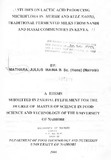| dc.contributor.author | Mathara, Julius M | |
| dc.date.accessioned | 2013-05-27T09:07:50Z | |
| dc.date.available | 2013-05-27T09:07:50Z | |
| dc.date.issued | 1999 | |
| dc.identifier.citation | Degree of Master of Science in Food Science and Technology | en |
| dc.identifier.uri | http://erepository.uonbi.ac.ke:8080/xmlui/handle/123456789/26121 | |
| dc.description | Submitted in partial fulfillment for the
Degree of Master of Science in Food
Science and Technology of the University
of Nairobi | en |
| dc.description.abstract | The following study gives information on identity and some characteristics of
fermentative lactic acid producing microflora isolated from Mursik and Kule
naoto, traditional fermented milk products from Nandi and Masai communities
respectively. Both products were assessed for their chemical and microbial
composition. The study showed that the fermented milk products had high ash
content compared to the raw or commercial processed milk. Protein content in
Mursik was higher than that of fresh milk possibly due to addition of boiled blood
before fermentation, and concentration through whey removal. Both products had
no coliforms; an indication of either good hygienic processing practices or
antimicrobial activity against the coliforms.
Several species of lactic acid bacteria together with some yeasts and molds
were isolated from the products, and their physiological and biochemical
characteristics determined. The study showed that Lactobacillus and Lactococcus
species are the dominant lactic acid bacteria in Mursik and Kule naoto
respectively. Saccharomyces yeasts and Ospora lactis molds were found to be the
dominant fungal microflora in both products. The yeasts and molds increased,
while the lactic acid bacteria decreased with storage.
Isolated dominant lactic acid bacteria showed varying functional
properties namely, acid production, proteolytic and anti-microbial activities.
Investigations on the fermentation characteristics of the isolates under controlled
laboratory conditions showed that several isolated strains of Lactobacillus species
of bacteria and Ospora lactis mold could be used in the commercial development
of fermented milk product, with good quality attributes and possibly longer shelf
life. Strains of Lactobacillus plantarum and Lactobacillus confusus species
isolated exhibited good proteolytic and anti-microbial activities. | en |
| dc.language.iso | en | en |
| dc.publisher | University of Nairobi | en |
| dc.title | Studies on lactic acid producing microflora in mursik and kule naoto, traditional fermented milks from Nandi and Masai communities in Kenya | en |
| dc.type | Thesis | en |
| local.publisher | Department of food technology and nutrition | en |

